The Bureau of Labor Statistics (BLS) released its annual National Census of Fatal Occupational Injuries reportfor 2019 a few weeks ago, and the findings are grim. Some 5,333 workers died from job-related injuries in 2019, the largest annual number since 2007. Nearly 20 percent of these fatalities (1,061) were in the private construction industry alone.
These numbers show just how vital it is to double down on safety efforts. In the spirit of the new year, we’ve assembled five worker safety risk management resolutions construction and utility companies should carry out to prevent worker injuries and fatalities in 2021 and beyond.
2021 resolutions to improve construction and utility worker safety
Participate in worker safety efforts at the executive level
Safety is frequently among construction and utility companies’ core values. But, seeing as there are several degrees of separation between field workers and themselves, safety isn’t necessarily at the forefront of executives’ minds...or at the center of their plans.
Executives influence upper management, who influence middle management, who influence workers. In order for everyone in the company to take safety seriously, executives must make 2021 the year they practice the safety credos they preach.
What does this mean? First, executives should consider the actions their companies can take at the highest level to prevent worker injuries and fatalities and ensure they’re included in 2021 company plans. This might mean starting a company-wide safety initiative, for example.
Then, executives should visibly support safety efforts. Go to worksites to observe pre-job safety meetings, shadow safety audits, participate in safety stand downs, and hold safety-centered town halls where workers can ask questions directly.
Regularly talk to workers about safety
How often does your company talk to workers about safety? Every day? Week? Month? Or, is safety addressed less often, usually after incidents occur?
In 2021, resolve to be more proactive with safety training. If they’re not doing so already, have supervisors hold daily pre-job safety meetings. Also consider holding one safety stand down every month or quarter that is focused on a timely safety issue. A good construction safety management topic to tackle right now is how to work safely in winter weather. Or, you could focus on how workers can best protect themselves in the workplace from COVID-19. In the spring, consider the topic of fall prevention, as it corresponds to the Occupational Safety and Health Administration’s National Safety Stand-Down To Prevent Falls in Construction.
You might like: Damage Prevention and the Challenge of Keeping Communities Safe During a Pandemic
Hold meaningful worksite safety audits
Worksite safety audits can help construction and utility companies identify and correct oversights that could lead to injuries and fatalities if not addressed. But, all construction and utility worker safety audits are not created equal. In a conference presentation, Matthew Hallowell, Ph.D., Director of the Construction Safety Research Alliance, offered techniques for carrying out more effective safety audits.
First, Dr. Hallowell said, auditors should ask open-ended questions instead of yes or no questions. “What’s not a good question is, ‘Do you know the safe work procedure?’ That yes or no question will almost always get the, ‘Yup, boss, I’m good,’” Dr. Hallowell said. “Instead, ask a more covert question, which is, ‘Tell me about your work today and how you’re going to work safely.’”
Other tips include sending an auditor who is experienced in the work being done and has a relationship with the workers. He also suggested holding the audit where the work is being performed. “Having discussions in the job trailer is not as effective as going out to the field,” he said.
Dr. Hallowell also advised auditors to ditch the clipboard. “I highly recommend just going on a walk and talking with people. It's a lot better to ask 90 percent of the questions you had intended and do that really well than [to ask] 100 percent and have a clipboard and have people give you the answers they think you want to hear.”
Implement safety management software
Studies show that construction workers can only identify 45 percent of worksite hazards on their own, meaning the majority of hazards are undetectable, even to veteran workers.
Make 2021 the year you better identify the warning signs of looming safety incidents. Implementing the safety management software Urbint Lens for Worker Safety allows supervisors to get ahead of safety incidents with specific risk-based information. The software, which is built for mobile devices like toughbooks and tablets, takes a holistic view of construction projects and uses machine learning to reveal hidden safety threats. This gives leaders the insight to implement targeted safety actions before incidents occur.
Reduce conditions that elicit unsafe work
Even the best, most experienced workers make mistakes. This is made evident by the fact that 2,005 workers aged 55 and above died from occupational injuries in 2019, an all-time high for this demographic, according to the BLS.
In the new year, resolve to improve worker safety by reducing conditions that negatively affect human performance. Take schedule pressure, for example. Workers who feel rushed to complete their tasks will be more pressured and fatigued and more likely to make mistakes than those who are given ample time.
Risk normalization, a phenomenon where dangerous practices gradually become acceptable over time, is another condition to address. A roofer, for example, will feel most confident scaling a building at the end of the day, but he should still wear the same personal protective equipment (PPE) he did at the beginning of the day when he was less self-assured.
There’s no better time than the start of a new year to make lasting changes. Use these worker safety resolutions as a guide to improve your company’s worker safety program this year and for years to come.

